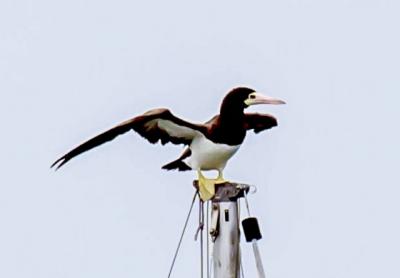A Love Letter to Montauk

Every once in a while we are visited by a strange species from the north, west, east, or south. These occurrences are called accidentals. On occasion, as in the case of the cattle egret, which is native to Africa, the exotic species will establish on another continent, as it did in South America, then visit a third continent, in this case, North America, and establish there. Those few bird species, such as the osprey, that are cosmopolitan and found on all continents, started on one and spread to the others, one continent at a time.
This October a different cosmopolitan species, the brown booby, common in the Caribbean countries and throughout tropical seas of the world, showed up in Montauk and may have found a new home. Most likely it was pushed up by one of the hurricanes, Jose or Maria, which moved up from the American tropics toward Long Island’s coast before turning easterly and heading out to sea. The brown booby is a spectacular bird, one of the biggest and most colorful of seabirds, with a wingspan approaching five feet. Unlike most pelagic birds, the albatrosses, gannets, etc., it is sexually dimorphic, with the males sporting a dark brown head, neck, and back, a white chin, and white undersides.
Without dwelling on the world-famous story of the so-called Montauk monster, Montauk is one of the places on Long Island where such accidentals frequently show up. And, not just birds. Tarpons have been caught off Montauk. One of the largest great white sharks was caught off Montauk. The Japanese shore crab has established in the rocky intertidal of Montauk Point. Not too long ago, a manatee from Florida made its home in Lake Montauk to the delight of many, some of whom fed it water from their hands.
Montauk had the first breeding turkey vultures on Long Island, the first gray and hooded seals. Montauk is also the home of the blue-spotted salamander, a native that is found nowhere else on Long Island.
The world is flush with animals and plants trading places and always has been. Montauk, halfway between the North Pole and the tropics and sticking out into the second largest ocean as it does, is the rightful spot for such a potpourri of species. Just about every rare pelagic bird known to man — including ivory, Iceland, glaucous, kittiwake and lesser black-backed gulls, two murres, all manner of petrels, and an occasional jaeger or two — have been recorded in the waters off Montauk Point.
Let’s not forget that Montauk has, or once had, the largest populations of a federally endangered flowering plant, the sandplain gerardia. After the Hempstead Plains, which was reduced to less than 20 acres over the course of the 20th century, Montauk has the largest prairie on Long Island and in New York State. It once included not only what is now Hither Woods, but also the state’s Montauk Downs golf course and the historical polo field and cattle ranch. Unfortunately, in the absence of major fires, that prairie, which once was home to prairie chickens, turkeys, and wolves, has been growing up into a shrubby savanna or heathland at a rapid pace.
Montauk is also an important aquatic habitat. Until Lake Montauk was opened to the sea in the mid-1920s, it was the largest freshwater lake on Long Island. Fort Pond, also in Montauk, is now the second largest, after Lake Ronkonkoma. Because there is a clay stratum between the deep sands and surface soils throughout much of southern Montauk, there are “perched wetlands” that are inhabited not only by eastern newts, spotted turtles, and a large variety of ferns and other rare-to-Long-Island wetlands plants. There are also several deep kettles, which have yet to be fully explored, that have wet bottoms covered with an unusual flora.
The Walking Dunes on Napeague, with their cranberry bog and sands that move southeasterly at a few millimeters a year, rival the Fire Island dunes in height and scope. The shad-and-holly-dominated moorlands of Montauk, running behind Long Island’s only ocean bluffs, are unique and sport several rare and unusual plant species, including the sandplain gerardia mentioned above.
Montauk is rich in glacial erratics, random large boulders that can be as large as a house. Some are land-bound, while others are off both the North and South Shores. The glacier that created almost all of Montauk’s land mass reached well offshore, thus the big rocks that stick up from the ocean’s surface here, and those larger ones that are permanently covered by water. Those that one comes across on land, such as Split Rock in Hither Woods, sport areas of green and gray lichens that are hundreds, perhaps thousands of years old.
I could go on and on. But it was the brown booby, which I have yet to see, that got me into this long account. It is obvious that my love for Montauk is unbounded, isn’t it?
—
Larry Penny can be reached via email at [email protected].
